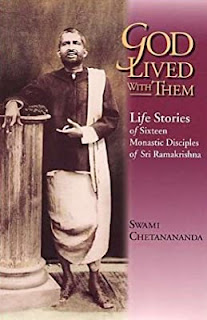God Lived with Them --- a Review
I read this 650-odd page book in September 2018. I did not intend to write a review of it until this morning when I did the index for the book, something that I do for all the books that I read: it helps me to remember the significant issues that have been raised in the work, the authors' views, and other factoids that are similar to the other books that I have read. I make cross-references, in this regard.
Some readers have hailed "God Lived with Them" as a masterpiece, and the majority have given it, if I may resort to the trite expression, "glowing reviews", and the people who have waxed lyrical about Swami Chetanananda's work have, in the main, been captivated by the intimate accounts of the 16 disciples, information which had, hitherto, been unknown, perhaps until this text, to the general public and people outside the Ramakrishna Mission.
I should agree that the work has afforded us the rare privilege to take a peek behind the history of the Mission, at the lives and even thoughts of the disciples who were trained by Swami Sri Ramakrishna. But I chose the work for another essentia reason: to examine the ideas and ideology of the Master who has, for about 150 years, been a curious source of fascination to spiritual aspirants as well as to people who endeavour to gain a deeper perception of the spiritual movements in India that have informed Hindu revivalism in the 20th century.
If I had not read the book, I should not have known that Sri Ramakrishna had 16 close disciples, and of whom five had received schooling, and of the five, two had been graduated from college, and ten of the 16 did not complete their formal education, and was one was even unlettered.
Including Sri Ramakrishna Paramahamsa, eight of them were Brahmins, and eight of the 16 disciples had had been acquainted with the Brahmo Samaj, which had largely been influenced by monotheistic religions and modern science, and had its foundation in reformed spiritual Hinduism with vital elements of Judeo-Islamic faith and practices. It was a socio-religious movement like Arya Samaj that appeared in India in the 19th century.
Although Brahmo Samaj was inspired by the Vedas, Upanishads and other Hindu scriptures, it believed in the Western philosophy and culture --- that explains why the Samaj had full faith in the British government.
Sri Ramakrishna Paramahamsa was familiar with and was favourably disposed to Brahmo Samaj, a fact that explains why he did not criticise his disciples who were in the grips of the Samaj's pernicious control.
I should thank the author for revealing a number of useful information about the 16 disciples' formative years, and about the doctrines and beliefs that formed the bedrock of the Mission. It is only when we get to make a close study of a spiritual person's mind, habits, beliefs and philosophy, which can be seen through their quotidian routines, can we say whether it is right to bestow upon him titles like "Mahatmas", "enlightened master" and "guru".
In the book, there are a number of disconcerting episodes in the lives of the 16 disciples and the Paramahamsa, which make us pause to review their teachings and satsangs. There are a quite a large number of incredible and incredulous assertions and proclamations that invariably cause one to wonder how the authors easily got away with them! Much of what Sri Ramakrishna Paramahamsa had preached, and many of the beliefs that Swami Vivekananda staunchly believed in are heterodox and infuriatingly iconoclastic. I am, therefore, not surprised that Swami Sivananda of Divine Life Society did not join the Mission.
I discovered a lot of contradictions between what 16 disciples and their Master preached and what they actually practised. Paradoxically, this could be one of the main reasons why many Indians and Hindus in the 20th century were sympathetic to Sri Ramakrishna and especially to Swami Vivekananda.
In these ways, the book has, to a considerable extent, allowed me to acquire a better understanding of the Mission and the people who laid the foundation for the organisation, which has always been shrewdly shrouded in mysticism and nebulosity.
I have given the book a five-star rating not because I subscribe to the Mission's strange beliefs but because the author has given me an opportunity to see the Mission as it is.





Comments
Post a Comment